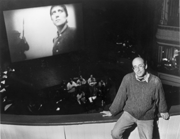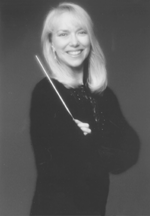An Arc du Triomphe
Richard Einhorn moves the Maid of Orleans from the burning stake and the screening room to Cabrillo Music Festival's centerstage
By Traci Hukill
Dressing like a man and daring to cut her hair were the least of the charges facing 19-year-old Joan of Arc in the spring of 1431. Two years prior, finally heeding the instructive "voices" she attributed to St. Michael and other angels, she had left her hometown disguised in men's clothes and marched to the city of Chinon where the exiled Dauphin Charles huddled with his retinue. In a short time, she convinced him of her mission--to save besieged Orleans and clear the road to Reims, the traditional crowning place of French kings.
Not only did she lead the French army to victory at Orleans and elsewhere, but she also stood by Charles' side at his coronation. When she was dragged from her horse in battle a year later and sold to the English, who planned to try her for heresy, Charles' thanks to her were to turn his bejeweled head and look the other way.
An ecclesiastic court tried her on 12 counts of witchcraft and heresy, and when she affirmed that the voices she heard were indeed those of saints, they excommunicated and burned her. Almost 500 years later, the Church recanted and declared her a saint.
The Maid of Orleans, as Joan of Arc came to be known, has fired the imaginations of countless artists and writers, including Voltaire, Anatole France and George Bernard Shaw, who wryly dubbed her the first Protestant. By far the best known study of her life is Danish film director Carl Theodor Dreyer's silent masterpiece, The Passion of Joan of Arc. Filmed in 1927 and released in 1928, The Passion's stark elegance and innovative use of bizarre camera angles and close-ups reverberated through the artistic community, securing its place even today as one of the greatest films ever made. The film debuted just eight years after Joan of Arc's canonization.
"The enigma, the mystery of Joan of Arc, is that no matter how much you try to imagine her, she's unimaginable," marvels Richard Einhorn. "To escape once, she leaped off a 70-foot tower. She was knocked out, but she survived--wholly survived. She expands one's own feelings about what is possible."
Composer Einhorn knew none of this as he flipped idly through a catalog of silent films in the New York Museum of Modern Art film archives one January day in 1988. When he came across a still from The Passion he remembered that a friend had suggested Joan of Arc as a topic some years before, so he asked to view the film.
"Some 81 minutes later, I walked out of the screening room shattered, having unexpectedly seen one of the most extraordinary works of art that I know," he recalls. "I immediately began to write the piece about Joan of Arc that my friend had suggested."
Might Makes Light: Choral director Cheryl Anderson leads the powerful Cabrillo Symphonic Chorus in CabMuFest's "Voices of Light," performed on Saturday evening at the Civic Auditorium.
Quest for Early Feminist Mystics
Though Einhorn knew right away how he would plot out the piece, Voices of Light, which commands centerstage at Saturday night's Cabrillo Music Festival, took six years to materialize. While the ideas germinated, he feverishly studied accounts of Joan's life, including letters the illiterate heroine dictated to a scribe. He read, too, the writings of medieval poet Christine de Pizan, hailed by some as the first feminist, and unearthed memoirs by female mystics of Joan's time. Eventually those voices found a home in his libretto.
Einhorn realized the music would have to be extraordinary. Joan, he learned, resisted formulaic treatment. True, she was a pious, illiterate country girl on a divine mission, but she also was friend and leader to a band of soldiers notorious for their brutality. She insisted on chastity from her army and would smack prostitutes with the flat side of her sword, but her kindness to dying enemy soldiers was legendary.
Although she was a devout Catholic, Joan of Arc took a crucial step away from the grip of the Church when she chose to honor her personal relationship with God over her duty to organized religion. Some 100 years later, Martin Luther would pick up this thread and ignite the Protestant movement, but the 19-year-old girl, whose belief in her communication with divine powers saved France, was on her own.
Einhorn, who describes himself as a privately religious person, finds Joan's spiritual issues still relevant. "Many people today experience a desire to feel focused about God, but have no interest in organized religion. Joan is a hero for those people," he points out.
On his travels, Einhorn came across two covens that worship Joan of Arc as a powerful witch. She also is currently enjoying a renaissance in popularity among feminists as a strong female figure representative of unorthodox spirituality.
But it isn't just the mighty figure of Joan of Arc that Voices of Light illuminates. The oratorio, though not a score to The Passion of Joan of Arc--some 16 of those already exist--often accompanies screenings of the classic film, as in the case of Saturday evening's performance at the Santa Cruz Civic Auditorium. So it must be worthy of the movie's intensity and a companion to its mood. And like its mysterious and charismatic subject, The Passion of Joan of Arc seems uneasily caressed by the hand of fate.
Director Carl Theodor Dreyer flouted convention from the start by casting 33-year-old Renée Falconetti as the adolescent Joan. The mood on the set must have been--what else?--intense. When Falconetti's head was shaved for the last few scenes, both she and the crew burst into tears. The exacting Dreyer dug holes all over the floor of the set to facilitate filming his odd angles. None of the actors wore makeup.
But when the editing was finished and The Passion of Joan of Arc made its debut, Dreyer's idiosyncrasies--even his penchant for close-ups and his oddly rhythmic editing style--proved to be blooms of genius. Of course the requisite few critics groused that the film amounted to little more than a collection of stills, but most of the art world seemed to agree with New York Times writer Mordaunt Hall, who effervesced in 1929: "As a film work of art, this takes precedence over anything that has so far been produced. It makes worthy pictures of the past look like tinsel shams."
The Church, not surprisingly, was less appreciative.
Then, several months after The Passion's release, a warehouse fire consumed the negative and almost all prints of the film. Dreyer, in a fit of the obsessive behavior that actors and crew members knew well, set about reconstructing the film from his own working footage. Unbelievably, a second fire destroyed the reconstructed version. This time Dreyer threw up his hands and went on to his next project.
A few suspect reconstructions circulated, one of which so offended Dreyer that he refused to recognize it as the film he made. Finally, in 1981, several film cans were discovered in the back of a closet in a mental institution in Oslo, Norway. They were shipped unopened to the Norwegian Film Institute, where they were found to contain a pristine print of the original Dreyer film.
The Voice of Angels
These were the legends facing Richard Einhorn in 1993 when he petitioned the Northampton Arts Council of Massachusetts to underwrite the research and writing of an opera/oratorio inspired by The Passion of Joan of Arc but able to stand alone as a "meditation on the life and personality of Joan of Arc." The funding enabled him to travel to France, where he followed Joan's path from her birthplace of Domremy to Rouen, the site of her trial and execution.
"It was one of the more unforgettable experiences that I've had," he says, speaking of the time he spent in Domremy. "I arrived on my birthday. It was five years after I'd first had the idea to write the piece." Knowing that bells triggered Joan's voices, he recorded the sound of the church bells at Domremy and incorporates them into each performance of Voices of Light.
Upon his return home, Einhorn sat down and whipped out 700-odd pages of music in three-and-a-half months, working 15 hours a day. "I know what I like. I certainly knew this material very well," he explains. "Writing music is not like writing words. Most composers rarely ever have writer's block."
Einhorn solved the problem of an elusive Joan by musically acknowledging the intriguing duality in her character. Besides, as he put it, "Since no one knows what Joan looked like, I decided that no one would know much about her singing voice." So Joan's words--the oratorio has no characters in a conventional sense--are sung by an alto and soprano together in a simple polyphonic line that's hauntingly medieval.
Joan's text is extracted from the Bible, her own letters and the writings of the 13th-century penitent Blessed Angela of Foligno and other female mystics.
Voices of Light has enjoyed huge success. Its 1994 Northampton premiere sold out in spite of the worst blizzard of that year, and it has twice sold out performances at the Brooklyn Academy of Music. Symphony orchestras from Los Angeles to New York performed it, and last year Sony Classical released a CD featuring Radio Netherlands Philharmonic and Choir and the medieval singing group Anonymous Four.
After an upcoming 30-city tour with Anonymous Four is complete, Voices of Light will have been performed about 50 times in the two-and-a-half years since its opening night--the equivalent of a smash hit in the classical music industry.
Einhorn seems determined to rescue Joan from her most recent fate as mascot for French right-wing nationalists, who appear to have missed the point of her martyrdom altogether. And who knows? With a crusade led by screenings of Dreyer's crushing film and performances of the hair-raising Voices of Light, he just might succeed in saving her from her most dismal and misunderstood hour yet.
This page was designed and created by the Boulevards team.

Inspired By Passion: New Yorkbased composer Richard Einhorn, shown here before a screening of Carl Theodor Dreyer's "The Passion of Joan of Arc," drew inspiration from the classic silent film for his oratorio "Voices of Light."

Paul Schraub
Voices of Light: The Passion of Joan of Arc will accompany the performance of Voices of Light conducted by Marin Alsop and sung by the Cabrillo Symphonic Chorus under the direction of Cheryl Anderson on Saturday (8pm) at the Civic Auditorium, 302 Church St., SC. Tickets cost between $7 and $24. Composer Richard Einhorn will introduce the piece.
From the August 1-7, 1996 issue of Metro Santa Cruz
Copyright © 1996 Metro Publishing and Virtual Valley, Inc.
